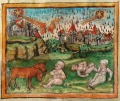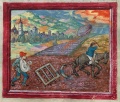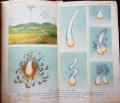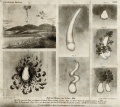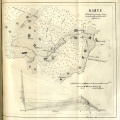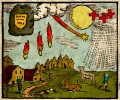(Unless otherwise stated, the copyright of the materials included belong to Jan Woreczko & Wadi.)
Kategoria:Bolidy historyczne
Z Wiki.Meteoritica.pl
Spis treści |
Doniesienia historyczne o obserwowanych do 1905 roku „wydarzeniach”: bolidach, jasnych meteorach, spadkach (sprzed 1905 roku, tzn. daty ukazania się opracowania Kleina (1904)).
Większość zamieszczonych tu informacji oparta jest na katalogach Chladniego, Kleina (1904), Grega (1861) i Boguslawskiego (1854, 1854a). Również kilka doniesień zaczerpnięto z artykułów Pokrzywnickiego dotyczących bolidów.
Warto odnotować takie wydarzenia, nawet jeśli nie można ich obecnie interpretować jako spadki meteorytów. Być może w przyszłości uda się część zamieszczonych tu dat i miejsc powiązać z innymi wydarzeniami natury meteorytowej. Jednym z kryteriów wyboru doniesień z wymienionych katalogów była nie tylko ich lokalizacja, ale także skala zjawiska. Pominięto tu na Wiki.Meteoritica.pl doniesienia o meteorach/bolidach małej jasności, zakładając, że nie spadły w ich wyniku meteoryty[1].
Bolidy historyczne
Poza znanymi i identyfikowalnymi zdarzeniami są u Grega (1861) jeszcze następujące doniesienia o bolidach (ang. fireball, bolide, fr. bolide, niem. Feuerkugel, ros. болид) (część z nich została również wcześniej opisana u Boguslawskiego (1854, 1854a)):
Greg (1861)[2]
Catalogue of aërolites and Bolides, from A.D. 2 to A.D. 1860 Year. Day of month. Locality. Size or weight. Direction. Duration; rate; hour; Remarks, &c. 1135.* ? Oldesleben, Thuringia … … … Stone-fall?. 10 inches diameter (or A.D. 1136). (patrz → Steinbach) 1164.* May Misnia, Saxony … … … Iron-fall?. About the feast of Pentecost. (patrz → Steinbach) 1249.* July 26 Quedlinburg … … … Stone-fall; many?. (patrz → Quedlinburg) 1304.* Oct. 1 Saale, Saxony … … … Stone-fall; many?. Friedland or Friedberg. (patrz → Friedland 1304) 1305.? ? Vandal towns … … … Stone-fall?; in Lusatia (Saxony); probably same as October 1, 1304. (patrz → Friedland 1304; Bolid wielkopolski) 1339.? July 13 Silesia … … … aërolitic (Baumhauer's Catalogue). 300 thunderbolts said to have fallen during a thunderstorm; can hardly be considered aërolitic. (patrz → Śląsk 1339) 1511.* Sept. 4 Crema, N. Italy … … … Stone-fall; many from 1 lb. to 8 lbs. (patrz → Madonna di Foligno (Rafael, obraz)) 1545.* ? Neuhof, Saxony … … … Iron-fall; fell or found?. Grimma, Saxony. 1540 according to Boguslawski. (patrz → Steinbach) 1548.* Nov. 6 Mansfeld, Thuringia ½ moon W. to E. 2 A.M. detonating meteor; aërolitic? (Baumhauer); a substance said to have fallen from it like coagulated blood! 1572.? 9 Thorn … … … aërolitic (according to Baumhauer's Catalogue). Doubtful fall, according to Chladni. (patrz → Toruń 1572) 1591.* June 9 Kunersdorf … … … Stone-fall; several large stones (19th June?). (patrz → Kunersdorf 1591) 1636.* Mar. 6 Sagan, Silesia … … 6 A.M. Stone-fall; one large one. (patrz → Sagan (Dąbrowa Łużycka)) 1660. Feb 23 Wittenberg … … … fireball. (patrz → Bolid 1660) 1715.* Apr. 11 Schellin, Pomerania 15 lbs. +½ … 2 P.M. Stone-fall; Prussia. (patrz → Schellin (Skalin)) 1717.? ? Hungary … … … aërolitic fall; Poggendorff, iv. 1854, p. 33. Hungary; probably only the meteor of August 10, seen in Bohemia, Hungary, Prussia, &c. The Reports of the British Association of 1849, state that a stone fell, but this does not seem to be correct. (patrz → Opole 1716) 1723.* June 22 Plescowitz, Bohemia … … 2 P.M. Stone-fall; 33 picked up, one of 6 lbs. (patrz → Ploschkovitz) 1729. Oct. 16 Warsaw … … … fireball. (patrz → Warszawa 1729) 1750.? Feb. 9 Silesia … … … fireball; aërolitic (according to Baumhauer's Cat.) Silesia; a fireball, said to have fallen down in fragments. (patrz → Śląsk 1750) 1753.* July 3 Tabor, Bohemia 13 lbs.+ … 8 P.M. Stone-fall; several; sp. gr. 3.65. (patrz → Tabor) 1775.* ? Obruteza, Russia … … … Stone-fall. in Volhynia. (patrz → Owrucz) 1796.* Jan. 4 Bielaja, Zerkwa, Russia … … … Stone-fall; several. (patrz → Bjelaja Zerkov) 1798.* Dec. 13 Benaes, India … … 8 P.M. Stone-fall. (patrz → Kraków 1798) Od roku 1800 (poniżej) nie wyszczególniono już części doniesień o udokumentowanych spadkach, a zawartych w wykazie Grega (patrz → Kalendarium) 1803. Jan. 21 Silesia … … … a shooting-star; got larger and larger till it fell to earth. 1803. January 21. Between Barsdorf and Freiburg. Seemed to pass close to the ground; a whizzing noise heard, then it seemed to lie burning on the ground; next day a jelly-like mass found on the snow. Curious, if true. (patrz → Bojanowo 1803) 1805. Oct. 21 Sweden … … … fireball. (patrz → Świdnica 1805) 1811.* Mar. 12 Poltawa, Russia 13 lbs.+ … night Stone-fall; two fell; sp. gr. 3·49 Kuleschofka.. (patrz → Kuleschovka) 1821. Feb. 12 Breslau … … … fireball. 1821.? Mar. 5 Pomerania … … … aërolitic fall (Boguslawski and Poggendorff). A doubtful fall; occured during an earthquake, supposed to have been caused by the explosion of a meteor. Chladni thinks that the holes in the ground might have been caused by falling stones, which were not found because not searched for. (Gilbert's Ann., lxxi. 1822, p.560). (patrz → Greifswalder Kreise 1821) 1821. Dec. 4 Görlitz … … … fireball. 1821.* Dec. 24 Bromberg; Wirtemberg large E. to W. 6 P.M. fireball; accompanied with detonation. (patrz → Bolid 1821) 1822. Aug. 23 Posen … … … fireball. (patrz → Bolid 1822) 1823. Oct. 3 Königsberg[3] … … … fireball. 1824. Feb. 3 Görlitz … … … fireball; aërolitic?. 1825. Jan. 24 Königsberg[3] … … … fireball. 1830. Dec. 14 Warsaw … … … fireball. 1831. Jan. 12 Breslau … … … fireball. (patrz → Wrocław 1831) 1834. Feb. 4 Upper Silesia = moon … … high up in the sky. At Cracow chiefly. (patrz → Śląsk 1834) 1834. Mar. 10 Hirschberg[4], Silesia … … 3½ A.M. a brilliant meteor; exploded like thunder. (patrz → Hirschberg 1834) 1835. Jan. 12 Breslau … … … fireball. 1835. June 13 Königsberg[3] … W. to E. … a reddish fireball. (patrz → Königsberg 1835) 1836. Oct. 18 Breslau large … … short tail; no noise. (patrz → Wrocław 1836) 1836.? Nov. 22 Silesia … … … atmospheric explosion. (patrz → Śląsk 1836) 1837. Aug. 29 Upper Silesia … … slow with reddish tail. (patrz → Śląsk 1837) 1837. Dec. 30 Trebnitz … N. to S. … by day-light; bright silver-white; sparks after. (patrz → Trzebnica 1837) 1838. Jan. 2 Breslau large N.E to S.W streak 2' cast shadows; blue, red. (patrz → Wrocław 1838) 1841.* Dec. 5 Goldberg[5], Silesia = full moon S.W. to N.E. 1' lighted up all the sky; bluish; detonation?. 6.45 P.M. Silesia, Hirschberg, Breslau, Oderberg, Lukenwald, and other places. In bursting, fell into many stars equal 1st mag. in size. Intense light; some heard a report. (patrz → Śląsk 1841) 1842. Aug. 5 Silesia? large N.W. to S.E. 8.20 P.M. moved parallel to horizon about 4° high; tailed. Seen by Boguslawski, probably at Breslau; had a smoke-like tail; twilight; burst in 10", leaving a black smoke which slowly ascended, broke up and vanished. Baumhauer, in his Catalogue, refers to the stone-fall same day at Harrowgate. (patrz → Śląsk 1842 Aug) 1842.* Oct. 23 Silesia, &c. large S. to E. 90° in 3" brightest at first; sparks; detonation; 8½ P.M. All over Silesia; long rumbling sounds in the air afterwards. (patrz → Śląsk 1842 Oct) 1844. Sept. 5 Overall, Silesia very large E. to W. 8", slow nearly horizontal; reddish streak; conical. At Hirschberg; horizontal; slow; E. to W.; like a wine-decanter; greenish-yellow tail; of 4' or 6' in width; brilliant. Also seen at Posen; must have been very high up; detailed accounts sent in from 35 places; burst into several bright stars, which vanished, leaving only a reddish streak; at Breslau, like a large bright lamp; moved in a curved arc of 50° in length; tail 1½° long. (patrz → Śląsk 1844) 1845.? Jan. 20 Grüneberg, Silesia … N.W. to S.E. remarkable fiery meteor and tail; detonation?. (patrz → Zielona Góra 1845) 1846. Mar. 31 Upper Silesia … … quick bright silvery; short tail. (patrz → Śląsk 1846 Mar) 1846. Oct. 24 Silesia; many places large … 6.45 P.M. burst into small sparks; no noise; left a small dark cloud for 2'. (patrz → Śląsk 1846 Oct) 1846. Nov. 18 Breslau, and other places … … … like a fiery serpent; no noise. Silesia. Left a bright cloud for 10", composed of three parts. Many places in Silesia. (patrz → Wrocław 1846) 1847. Nov. 7 Trebnitz[6], Silesia … … slow bright fireball. (patrz → Śląsk 1847) 1847. Dec. 13 Breslau … … streak 6 or 7" tail 4° long; rapid; serpentine movement. (patrz → Wrocław 1847) 1848. Mar. 8 Breslau … … … straight down. 1847?. 1848. May 19 Silesia … … … large bolide; or 20th May.. (patrz → Śląsk 1848) 1850. Apr. 21 Breslau … … 25" or 30" bright meteoric light, increasing and decreasing; burst as it sank below the horizon. (patrz → Wrocław 1850) 1852. Jan. 3 Cracow … … … bolide. 1852. Sept. 28 Silesia; Breslau large ┴ down 8¾ A.M. seen over all Silesia; tailed; during sunshine; no noise. (patrz → Śląsk 1852 Sep) 1852. Dec. 9 Cracow … … … fireball. 1852. Dec. 11 Germany … … … detonating meteor. See Supplement. (patrz → Śląsk 1852 Dec 11; Niezidentyfikowane 1852 i 1861) 1853. Feb. 14 Cracow … … … fireball. 1853. Oct. 26 Pomerania large … … left a spiral trail. 1858.? Aug. 4 Berlin, Stettin[7], &c. … … 6" fireball; detonation?. Seen also at Münster and Oderberg. See Buchner's work, pp. 171 and 181. This meteor is said to have twice changed its direction each time of its apparent bursting, and sending out reddish-coloured sparks. (patrz → Bolid 1858) 1859[8] May 15 Westphalia … N.W. to S.E. 4" fireball; path oblique; no train. (patrz → Kuniewo)
Lokalizacja
* W 2018 roku Google zmieniło zasady działania apletu, mapa może wyświetlać się niepoprawnie (pomaga Ctrl+F5); więcej → Szablon:GEMap-MyWiki
Bibliografia
Historyczne doniesienia o bolidach i prawdopodobnych spadkach meteorytów:
- Baumhauer Eduard Hendrik von, (1845), Ueber den muthmasslichen Ursprung der Meteorsteine, nebst einer Analyse des Meteorstein, welcher am 2. Juni 1843 in der Provinz Utrecht gefallen ist, Annalen der Physik, 66, Bd. 142, 1845, s. 465-503.[9] Plik DjVuŹródło: Wiki.Meteoritica.pl.
- Boguslawski Georg von, (1854), Zehnter Nachtrag zu Chladni's Verzeichnisse der Feuermeteore und herabgefallenen Massen (Wien 1819), Annalen der Physik, IV, 90 uzupeł. (ergänzungsband), 1854, s. 1-155. Plik DjVuŹródło: Wiki.Meteoritica.pl.
- Boguslawski Georg von, (1854a), Zehnter Nachtrag zu Chladni's Verzeichnisse der Feuermeteore und herabgefallenen Massen (Wien 1819) (Schluss von S. 155.), Annalen der Physik, IV, 90 uzupeł. (ergänzungsband), 1854, s. 353-456. Plik DjVuŹródło: Wiki.Meteoritica.pl.
- Buszczyński Bolesław, (1887), O niektórych zjawiskach jasnych meteorów czyli kul ognistych lub bolidów. Napisał Bolesław Buszczyński, asystent obserwatorium astronomicznego w Krakowie, Kosmos, 12, Lwów 1887, s. 85-87 (Sect. Rozpr. Nauk), s. 103-106. Plik sLib.
- Chladni Ernst F.F. patrz → podstrona Bibliografia: Chladni Ernst F.F.
- Czajka Wiesław, (2011), Weryfikowanie XIX-wiecznych katalogów spadków z terytorium Polski (Verification of the Catalogues of Meteorites and Fireballs from XIX Century in the Territory of Poland), Acta Soc. Metheor. Polon., 2, 2011, s. 16-24. Plik PDF; plik ASMP.
- Greg R. Philips, Esq., F.G.S., (1861), A Catalogue of Meteorites and Fireballs, from A.D. 2 to A.D. 1860[10], Report of the British Association for the Advancement of Science (B.A.A.S.), 30th Meeting (1860), London 1861, s. 48-120.[11] Źródło: MeteoriteHistory.info; plik DjVu; plik PDF; wersja full-HTML (h) (str. tytułowa).
- Kämtz Ludwig Friedrich, (1836), Lehrbuch der Meteorologie. Dritter Band, Halle, 1836. O bolidach. Plik PDF.
- Klein Hermann Joseph, (1904), Jahrbuch der Astronomie und Geophysik. Enthaltend die wichtigsten Fortschritte auf den Gebieten der Astrophysik, Meteorologie und physikalischen Erdkunde, XIV. Jahrgang 1903, Eduard Heinrich Mayer, Leipzig 1904. Plik DjVu (str. tytułowa).
- Łaszkiewicz Antoni, (1936), Meteoryty, rozdz. w: Mineralogia, Bibl. „Wiadomości Farmaceutycznych”, tom 28, Warszawa 1936, s. 193-195. Tam lista polskich meteorytów z uwzględnieniem granic przedrozbiorowych. Plik DjVuŹródło: Wiki.Meteoritica.pl.
- Morozewicz Józef, (1931), Części składowe meteorytów i Wykaz meteorytów spadłych na historycznych ziemiach polskich, w: Tschermak G., Becke F., Podręcznik mineralogji, wydanie polskie, Warszawa 1931, s. 806-816. Tam lista polskich meteorytów z uwzględnieniem granic przedrozbiorowych. Plik DjVuŹródło: Wiki.Meteoritica.pl.
- Pokrzywnicki Jerzy, (1963), Meteoryty, meteory i bolidy w starożytności, Z Otchłani Wieków, r. XXIX, z. 1, 1963, s. 18-23.
- Pokrzywnicki Jerzy, (1960), O bolidach obserwowanych nad Polską, Acta Geophys. Polon., vol. VIII, nr 3, 1960, s. 224-257.[12] Plik DjVuŹródło: Wiki.Meteoritica.pl.
- Pokrzywnicki Jerzy, (1965), O bolidach obserwowanych nad Polską – II, Acta Geophys. Polon., vol. XIII, nr 3, 1965, s. 207-215.[12] Plik DjVuŹródło: Wiki.Meteoritica.pl.
- Pokrzywnicki Jerzy, (1965), Sur les bolides observés en Pologne, Bulletin de la Société des Amis des Sciences et des Lettres de Poznań. Série B. Sciences mathématiques et naturelles, Livr. XVIII, Poznań 1965, s. 103-111.[12] Plik DjVuŹródło: Wiki.Meteoritica.pl.
- Pokrzywnicki Jerzy, (1969), O bolidach obserwowanych nad Polską – część IV, Acta Geophys. Polon., vol. XVII, nr 2, 1969, s. 203-209.[12] Plik DjVuŹródło: Wiki.Meteoritica.pl.
Przypisy
Zobacz również
Linki zewnętrzne
- Wikipedia – Niemieckie nazwy polskich miejscowości
Strony w kategorii „Bolidy historyczne”
Poniżej wyświetlono 76 spośród wszystkich 76 stron tej kategorii.
Pliki w kategorii „Bolidy historyczne”
W tej kategorii są 32 pliki z ogólnej liczby 32 plików.


